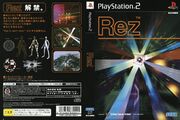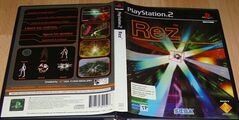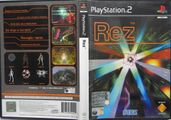Rez
From Sega Retro
| Rez | ||||||||||||||||||||||||||||||||||||||||||||||||||||||||||||||||||||||||||||||||||||||||||
|---|---|---|---|---|---|---|---|---|---|---|---|---|---|---|---|---|---|---|---|---|---|---|---|---|---|---|---|---|---|---|---|---|---|---|---|---|---|---|---|---|---|---|---|---|---|---|---|---|---|---|---|---|---|---|---|---|---|---|---|---|---|---|---|---|---|---|---|---|---|---|---|---|---|---|---|---|---|---|---|---|---|---|---|---|---|---|---|---|---|---|
| System(s): Sega Dreamcast, PlayStation 2 | ||||||||||||||||||||||||||||||||||||||||||||||||||||||||||||||||||||||||||||||||||||||||||
| Publisher: Sega | ||||||||||||||||||||||||||||||||||||||||||||||||||||||||||||||||||||||||||||||||||||||||||
| Developer: United Game Artists | ||||||||||||||||||||||||||||||||||||||||||||||||||||||||||||||||||||||||||||||||||||||||||
| Distributor: Sony Computer Entertainment Europe (Europe) | ||||||||||||||||||||||||||||||||||||||||||||||||||||||||||||||||||||||||||||||||||||||||||
| Peripherals supported: Dreamcast VGA Box, Jump Pack, Visual Memory Unit Trans Vibrator | ||||||||||||||||||||||||||||||||||||||||||||||||||||||||||||||||||||||||||||||||||||||||||
| Genre: Midnight High Shooting (ミッドナイトハイシューティング)[1][2][3], Shooting[4] | ||||||||||||||||||||||||||||||||||||||||||||||||||||||||||||||||||||||||||||||||||||||||||
| Number of players: 1 | ||||||||||||||||||||||||||||||||||||||||||||||||||||||||||||||||||||||||||||||||||||||||||
| Official in-game languages: | ||||||||||||||||||||||||||||||||||||||||||||||||||||||||||||||||||||||||||||||||||||||||||
|
Rez (レズ) is a rail shoot-'em-up video game developed by United Game Artists and initially released by Sega simultaneously for the Sega Dreamcast and PlayStation 2 in 2001. It was conceptualized and produced by Tetsuya Mizuguchi and built by many former members of the disbanded Team Andromeda, the Sega development team behind the Panzer Dragoon series.
Mizuguchi's company, Q Entertainment, released a high definition version, Rez HD to the Xbox Live Arcade service in 2008.
Contents
Story
The game is set in futuristic computer "super network" called the K-project where much of the data flow is controlled by an AI named Eden. Eden has become overwhelmed with the amount of knowledge gathered on the network after a virus infects her, causing her to doubt her existence and enter a shutdown sequence, which would create catastrophic problems everywhere should she be able to complete this. The player plays the protagonist virus, Swayzak (the same that infected Eden earlier), invading Eden's mainframe and battling the mainframe's defense systems to reveal the true being at Eden's core.
The K-Project name and much of the game's visual and synesthesia inspiration comes from the Russian painter Wassily Kandinsky, whose name is mentioned at the very end of the game credits, whereas the Rez name was inspired by the Underworld track of the same name.
Gameplay
Rez is a rail shooter in which the player takes control of an onscreen avatar traveling along a predetermined path through the computer network. The player cannot affect his or her movement in any way. The player targets foes by holding a "lock-on" button while moving an aiming reticule over up to 8 enemies. Once the "lock-on" button is released, Swayzak fires shots that home in on each target. Failure to hit an enemy or projectile in time may cause a collision, which reduces Swayzak's current evolution level by one and changes his avatar's form. The game is over if Swayzak is hit while at his lowest possible level. At higher evolution levels, the avatar appears as a humanoid figure, while it appears as a simple sphere at the lowest level.
Some enemies drop power-up items when destroyed. Two different items enhance Swayzak's avatar by increasing his "evolution bar" by one and three points respectively. Another item enables Swayzak to trigger an "Overdrive", which releases a continuous shower of shots at all enemies on the screen for a short period of time. In some game modes, score bonus items also appear periodically.
The game consists of five main areas. The first four are divided into ten sub-sections and conclude with a boss battle. The final area contains a larger number of sections and a boss rush, in which the player must fight variations of the bosses from the first four areas. Swayzak then goes on to the network's core to restart Eden in a final boss battle.
The final area features a variable difficulty scale, depending on the player's performance in the first four areas. According to Sega, this system was employed to make the game more accessible to casual players, while also making it more challenging for experienced players, thus potentially increasing its replay value. In addition, completing all five levels unlocks alternate gameplay modes, color schemes and secret areas.
Unlike most games, Rez contains almost no sound effects or spoken dialogue. Instead, the game is set to trance music, which plays in the background and gradually evolves as Swayzak moves among sections. The music is enhanced by musical effects (such as trills and drums) generated by the player's actions, enemies and surroundings. Player actions are usually locked to the rhythm of the music, such that shots and hits against enemies occur exactly on each beat (as opposed to occurring in real time). Graphical elements such as the polygons that make up Swayzak's avatar, as well as background elements, also "beat" in time with the music. In reference to these coordinated effects, Sega focused its marketing of Rez primarily on the game's qualities of "synesthesia", the association of different senses and stimuli with one another.
History
The game is notable for replacing the typical sound effects found in most rail shooter games with electronic music, with sounds and melodies created by the player as they target and destroy foes in the game, leading to a form of synesthesia, enhanced by an optional Trance Vibrator peripheral made by ASCII. Although Rez was critically acclaimed, it did not get much commercial attention, particularly in the United States where a Dreamcast port failed to surface. Working titles for the game were K-Project, Project Eden, and Vibes, and before it was given a proper name, The Sound Project[14].
Versions
On the Dreamcast, Rez runs at a full 640x480 resolution at 30FPS, while on the PlayStation 2, the game opts for an interlaced mode, doubling its frame rate at the expense of graphical fidelity.
Both versions have been superseded since the rights moved from Sega; the 2008 Xbox 360 release of Rez HD brought the game up to 720p with a 60FPS target, and the 2016 PlayStation 4 release of Rez Infinite brought the visuals to 4K with virtual reality headset support. A 2017 PC conversion of Infinite supports up to 16K resolutions at higher frame rates, among various other graphical options.
Production credits
- Main article: Rez/Production credits.
Magazine articles
- Main article: Rez/Magazine articles.
Promotional material
Dreamcast version
PlayStation 2 version
Artwork
Gallery
Official photographs
Physical scans
Dreamcast version
| Sega Retro Average | |||||||||||||||||||||||||||||||||||||||
|---|---|---|---|---|---|---|---|---|---|---|---|---|---|---|---|---|---|---|---|---|---|---|---|---|---|---|---|---|---|---|---|---|---|---|---|---|---|---|---|
|
| 80 | |
|---|---|
| Based on 7 reviews | |
PlayStation 2 version
| Sega Retro Average | ||||||||||||||||||||||||||||||||||||||||||||||||||||||||||||||||||||||||||||||||||||||||||||||
|---|---|---|---|---|---|---|---|---|---|---|---|---|---|---|---|---|---|---|---|---|---|---|---|---|---|---|---|---|---|---|---|---|---|---|---|---|---|---|---|---|---|---|---|---|---|---|---|---|---|---|---|---|---|---|---|---|---|---|---|---|---|---|---|---|---|---|---|---|---|---|---|---|---|---|---|---|---|---|---|---|---|---|---|---|---|---|---|---|---|---|---|---|---|---|
|
| 77 | |
|---|---|
| Based on 18 reviews | |
Technical information
- Main article: Rez/Technical information.
ROM dump status
| System | Hash | Size | Build Date | Source | Comments | |||||||||
|---|---|---|---|---|---|---|---|---|---|---|---|---|---|---|
| ? |
|
2001-06-01 | GD-R | Page | ||||||||||
| ? |
|
2001-07-30 | GD-R | Page | ||||||||||
| ? |
|
230,785,296 | CD-ROM (EU) | SCES-50501 (V1.03) | ||||||||||
| ✔ |
|
230,773,536 | CD-ROM (JP) | SLPM-62101 (V1.01) | ||||||||||
| ? |
|
230,773,536 | CD-ROM (JP) | SLPM-74006 (V1.01) | ||||||||||
| ? |
|
230,785,296 | CD-ROM (US) | SLUS-20344 (V1.01) | ||||||||||
| ? |
|
2001-09-30 | CD-R | Page |
External links
- Sega of Japan catalogue pages (Japanese): Dreamcast, PlayStation 2
- Rez on PlayStation.com: JP, JP (PS2 the Best), JP (Special Package), US
References
- ↑ File:Rez dc jp backcover.jpg
- ↑ 2.0 2.1 2.2 http://sega.jp/dc/011103/ (Wayback Machine: 2008-01-12 17:27)
- ↑ 3.0 3.1 3.2 http://sega.jp/ps2/rez/ (Wayback Machine: 2001-12-13 22:57)
- ↑ https://sega.jp/history/hard/dreamcast/software.html (Wayback Machine: 2020-11-05 15:30)
- ↑ http://www.amazon.co.uk/exec/obidos/tg/stores/static/-/videogames/bs-dreamcast/ (Wayback Machine: 2002-02-14 23:45)
- ↑ http://www.chipsworld.co.uk/detProd.asp?ProductCode=5410 (Wayback Machine: 2002-03-07 08:15)
- ↑ https://groups.google.com/g/uk.games.video.dreamcast/c/P1nJy9u1Oyo/m/xXixtyrKeAIJ
- ↑ 8.0 8.1 Dreamcast Magazine, "No. 31" (UK; 2002-01-31), page 20
- ↑ http://www.amazon.de/exec/obidos/ASIN/B00005RJ9W (Wayback Machine: 2006-06-21 06:12)
- ↑ http://www.micromania.fr/zooms/?ref=19832 (Wayback Machine: 2002-12-18 15:27)
- ↑ Play, "12/2001" (DE; 2001-11-21), page 53
- ↑ 12.0 12.1 http://www.jp.playstation.com/software/title/slpm62101.html (Wayback Machine: 2007-05-14 11:16)
- ↑ 13.0 13.1 http://www.jp.playstation.com/software/title/slpm74006.html (Wayback Machine: 2006-07-02 02:43)
- ↑ Next Generation, "September 2001" (US; 2001-08-21), page 37
- ↑ 15.0 15.1 100% Consoles, "Février 2002" (FR; 200x-xx-xx), page 86
- ↑ 576 Konzol, "Január 2002" (HU; 2002-xx-xx), page 59
- ↑ Bonus, "1/2002" (YU; 2002-01-25), page 58
- ↑ Dorimaga, "2002-18 (2002-10-11)" (JP; 2002-09-27), page 33
- ↑ MAN!AC, "01/2002" (DE; 2001-12-05), page 71
- ↑ PSX Extreme, "02/2002" (PL; 2002-0x-xx), page 41
- ↑ Consoles +, "Janvier 2002" (FR; 200x-xx-xx), page 108
- ↑ Edge, "Christmas 2001" (UK; 2001-11-29), page 74
- ↑ Electronic Gaming Monthly, "February 2002" (US; 2002-01-08), page 156
- ↑ GamesMaster, "January 2002" (UK; 2001-12-20), page 91
- ↑ GMR, "February 2003" (US; 2003-01-07), page 93
- ↑ Hyper, "February 2002" (AU; 2002-01-02), page 75
- ↑ MAN!AC, "02/2002" (DE; 2002-01-02), page 62
- ↑ PlayStation 2 Official Magazine - UK, "January 2002" (UK; 2001-12-29), page 98
- ↑ Playbox, "Février 2002" (FR; 200x-xx-xx), page 55
- ↑ Play, "01/2002" (DE; 2001-12-19), page 108
- ↑ Players, "2/2002" (DE; 2002-01-02), page 64
- ↑ Play, "February 2002" (US; 2002-xx-xx), page 59
- ↑ PlayZone, "02/2002" (DE; 2002-01-02), page 106
- ↑ PSM2, "January 2002" (UK; 200x-xx-xx), page 65
- ↑ Power Unlimited, "Jaargang 10, Nummer 3, Maart 2002" (NL; 2002-0x-xx), page 46
- ↑ Silicon Mag, "February 2002" (US; 2002-0x-xx), page 24
- ↑ Xgen, "Únor 2002" (CZ; 2002-0x-xx), page 30
| Rez | |
|---|---|
|
Main page | Comparisons | Credits | Development | Magazine articles | Video coverage | Reception | Technical information | Bootlegs
| |
- Jump Pack-compatible games
- Dreamcast VGA Box-compatible games
- Visual Memory Unit-compatible games
- 1 player games
- JP Dreamcast games
- All JP games
- EU Dreamcast games
- All EU games
- DE Dreamcast games
- All DE games
- ES Dreamcast games
- All ES games
- FR Dreamcast games
- All FR games
- UK Dreamcast games
- All UK games
- Dreamcast games
- 2001 Dreamcast games
- All 2001 games
- Dreamcast shoot-'em-up games
- All shoot-'em-up games
- JP PlayStation 2 games
- US PlayStation 2 games
- All US games
- EU PlayStation 2 games
- DE PlayStation 2 games
- ES PlayStation 2 games
- FR PlayStation 2 games
- UK PlayStation 2 games
- IT PlayStation 2 games
- All IT games
- PlayStation 2 games
- 2001 PlayStation 2 games
- PlayStation 2 games with ADX audio
- All games
- Missing ROM hashes
- Games with known prototypes
- Old technical information
- Rez
- CD-ROM PlayStation 2 games






































